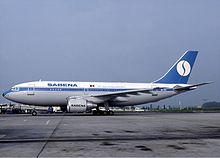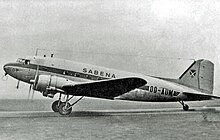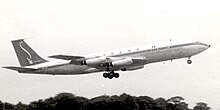Sabena
| Sabena | |
|---|---|

|
|

|
|
| IATA code : | SN |
| ICAO code : | SAB |
| Call sign : | SABENA |
| Founding: | 1923 |
| Operation stopped: | 2001 |
| Seat: |
Brussels , Belgium |
| Turnstile : | |
| Home airport : | Brussels-Zaventem |
| Company form: | Société Anonyme |
| Alliance : | Qualiflyer Group |
| Frequent Flyer Program : | Qualiflyer |
| Fleet size: | 49 |
| Aims: | National and international |
| Sabena ceased operations in 2001. The information in italics refer to the last status before the end of operation. | |
Sabena was Belgium's national airline from 1923 until its liquidation in 2001, with its headquarters in Brussels and its base at Brussels-Zaventem Airport .
history
1923-1939
Sabena - acronym for Société Anonyme Belge d'Exploitation de la Navigation Aérienne - went into operation on May 23, 1923 as the Belgian state line. It emerged from the SNETA ( Syndicat national pour l'Etude des Transports Aériens ), the national airline founded in 1919.
The first cargo flight of the Sabena went on May 23, 1923 with a stopover in Ostend to Lympne in Kent (Great Britain), and the first passenger flight was on April 1, 1924 from Rotterdam with a stopover in Brussels to Strasbourg . The route network was soon expanded to Amsterdam and Basel (via Strasbourg), and later to London , Bremen , Essen / Mülheim, Cologne and Copenhagen .
In part, the Sabena was formed on the initiative of Belgians in the Congo , who had only lost their first passenger and freight company LARA the year before, with connections between Leopoldville (now Kinshasa ), Lisala and Stanleyville (now Kisangani). The new national airline should now fill this gap - and in fact it opened a connection to the Belgian Congo as early as 1925 - an adventurous venture in this early phase of aviation history.
For their Congo campaign, the Sabena decided to use overland planes and began building airfields at several points in the colony. This program was completed in 1926 and commercial operations began on the main route Boma- Leopoldville-Elisabethville ( Lubumbashi ) (a 900 km stretch over dense jungle ). First machines from de Havilland were used, later three-engine aircraft of the type Handley Page W8f with ten seats.
By 1931, the Sabena's fleet, including its Africa subsidiary, had grown to 43 machines. On most European routes came Fokker - 7B and -7A machines used. The aircraft intended for the Congo flight network were only flown to the factory in the rarest of cases; mostly the delivery took place by water. A flight from Belgium to the Congo initially took almost a week, but in the course of the 1930s Sabena was able to negotiate better overflight rights together with Air France and Lufthansa and reduce flight times considerably: first to five and a half, later (using what was then the fastest Long-haul aircraft, a Savoia Marchetti SM.73 ) to just four days.
In Europe, the route network was constantly expanded in the 1930s (on the eve of the Second World War it was almost 6,000 kilometers) and mostly served with the then successful Junkers Ju 52 .
1939-1946
With the outbreak of the Second World War, almost all civil air traffic in Europe came to a standstill, and many machines were used for war purposes. Nevertheless, the Belgians managed to maintain their Congo route, one of the main arteries of traffic to and from Central Africa, almost without interruption - throughout the war .
1946-1960
When the war and the occupation of Belgium were over, the Sabena also resumed its routes within Europe - initially with the Douglas DC-3 , which the USA made available to European airlines . The company's official name was changed to SABENA - Belgian World Airlines . On June 4, 1947, a Sabena plane crossed the Atlantic for the first time and reached New York .
In 1949 Sabena acquired a 72.3% stake in the Belgian airline Sobelair . Sobelair remained an independent subsidiary and then carried out charter flights and feeder services for the Sabena.
The 1950s were all about modernization - the Sabena fleet was expanded with new machines from Douglas and Convair for a worldwide route network. However, the Congo route remained one of the most important pillars of the Belgians.
From September 1, 1953 to the mid-1960s, the airline maintained helicopter routes for passengers. The airports in Rotterdam, Antwerp, Lille, Eindhoven, Maastricht, Liège, Luxembourg, Paris, Dortmund, Duisburg, Cologne and Bonn were served from Brussels. The routes were flown first with Sikorsky S-55 , later with Sikorsky S-58 . In the first year of operation, 12,544 passengers were carried on 3,500 scheduled flights, which has brought Sabena the status of the world's most successful helicopter line.
1960-1990

The year 1960 marked a radical change for the Sabena: The Belgian Congo colony was granted independence, which inevitably had an impact on society's commitment to Africa. During the "Congo turmoil" of 1960 and 1961, most Belgians fled the crisis area in overcrowded Sabena planes, and the close-knit route network that had been built with great enthusiasm in the colony since the 1920s was now taken care of by the new Air Congo , in which Sabena only held a 30% minority stake.
Another kind of upheaval was brought about by the advent of jet aircraft technology: with the new Boeing 707 , Sabena was the first airline in mainland Europe to offer a jet connection to America. In 1961, medium- haul flights were almost completely converted to the new Caravelle , which was expected to increase efficiency. On March 14, 1969, Sabena founded the ATLAS consortium together with Air France , Alitalia and Lufthansa . In the 1970s, Boeing machines dominated the Belgian fleet, and the first Airbus machines were added in 1984 . At the same time, the Sabena began to expand its route network to West and Central Africa.
1990-2001
To meet the challenges of the 1990s, Sabena again adopted a new name - SABENA World Airlines - and a new design. But the Belgians were no longer a big player in the market and more than ever dependent on cooperation. In 1993 Air France acquired a minority stake in the company, but sold it again shortly thereafter. Two years later, Swissair took a 49 percent stake in Sabena - this maneuver was ultimately to prove fatal to both of them. In 1996 Sabena acquired the Belgian regional airline Delta Air Transport .
From the 1990s onwards, Thai Airways International flew the Brussels - Bangkok route with an MD-11 in code-sharing with Sabena.
The Boeing 747-200s , which had been in service since the 1970s, have been replaced by new Airbus A340 long -haul jets. In the late 1990s the design was changed again. The fleet was almost completely converted to Airbus by 2001, when the entire aviation industry fell into a deep crisis in the wake of the 9/11 attacks . At the time, Swissair owed Sabena $ 84 million, but declared itself insolvent on October 2. Then the Belgians were forced to keep their machines on the ground, and applied for just a day later bankruptcy protection . You only had three weeks to develop new sources of finance, but in this situation no other airline showed interest in joining Sabena.
So on November 6, 2001, they were forced to open the liquidation . After its bankruptcy , flight operations were continued by the Sabena subsidiary Delta Air Transport (DAT), which was named SN Brussels Airlines (now Brussels Airlines ) at the beginning of 2002 .
In 2011, the Luxembourg insurance company Axa Assurances Vie Luxembourg bought itself free of charges against Belgium for having participated in the tax evasion of the company's senior managers for 2.2 million euros .
aims
Africa
Abidjan, Accra, Banjul, Bamako, Bujumbura, Casablanca, Conakry, Cotonou, Dakar, Douala, Entebbe, Freetown, Johannesburg, Kigali, Kinshasa, Lagos, Lomé, Luanda, Monrovia, Nairobi, Ouagadougou, Sal, Yaoundé.
Asia
Bangkok , Beirut , Bombay , Chennai , Tel Aviv , Tokyo-Narita .
Europe
Ajaccio, Athens, Barcelona, Basel, Belfast, Berlin-Tempelhof, Bilbao, Birmingham, Bordeaux, Bologna, Bremen, Bristol, Bucharest, Budapest, Catania, Copenhagen, Dublin, Düsseldorf, Faro, Florence, Frankfurt, Geneva, Glasgow, Hamburg, Hanover, Helsinki, Istanbul, Leeds / Bradford, Lisbon, Ljubljana, Luxembourg, London-City, London-Gatwick, Madrid, Manchester, Milan-Linate, Milan-Malpensa, Moscow, Munich, Nantes, Naples, Newcastle, Nice, Nuremberg, Oslo-Gardermoen, Paris-Charles de Gaulle, Paris-Orly, Palma de Mallorca, Porto, Prague, Rome, St. Petersburg, Seville, Sheffield, Sofia, Stockholm-Arlanda, Strasbourg, Stuttgart, Turin, Valencia, Venice, Verona , Vienna, Warsaw, Zurich.
North America
Atlanta, Boston, Chicago-O'Hare, Cincinnati / Northern Kentucky, Dallas, Mexico City, Toronto-Pearson, Montreal-Dorval, New York-JFK, Newark.
Fleet (not complete)
Fleet at the end of operations
- 15 Airbus A319-100
- 6 Airbus A320-200
- 3 Airbus A321-200
- 6 Airbus A330-200
- 4 Airbus A330-300
- 2 Airbus A340-200
- 2 Airbus A340-300 (4 ordered)
- 6 Boeing 737-300
- 5 Boeing 737-500
- as well as 6 BAe 146-200, 12 Avro RJ100 and 14 Avro RJ85 operated by the subsidiary Delta Air Transport (DAT).
Previously deployed aircraft


- Airbus A310
- BAC 1-11
- Boeing 707
- Boeing 727
- Boeing 747
- Convair CV-240
- Convair CV-440
- De Havilland DH.114 Heron
- Douglas C-47
- Douglas DC-3
- Douglas DC-4
- Douglas DC-6
- Douglas DC-7
- Douglas DC-10
- Fokker F-27
- Fokker F28
- Junkers Ju 52 / 3m
- Lockheed Lodestar
- McDonnell Douglas MD-11
- Savoia-Marchetti SM.73
- Sud Aviation Caravelle
Earlier types of helicopters
Incidents
From 1945 until the end of operations in 2001, Sabena had a total of 24 total losses, 17 of them with a total of 459 fatalities.
From 1929 to the end of World War II, the company suffered fourteen total write-offs with 59 fatalities, four of which were aircraft losses due to war events. Extracts:
- On November 16, 1937, a Junkers Ju 52 / 3m ( aircraft registration number OO-AUB ) had an accident at Ostend during an unscheduled stopover at Steene Airport , near Ostend (Belgium). The machine collided with a factory chimney in poor visibility. All eleven occupants were killed in the controlled flight into terrain (CFIT), including the German glider pioneer and propeller designer Arthur Martens and almost the entire family of the former Hereditary Grand Duke Georg Donatus of Hessen-Darmstadt .
- On May 12, 1948 (in some sources May 13), a Douglas DC-4 (OO-CBE) got into a tornado on a domestic flight from Leopoldville to Libenge in the Congo and crashed into a forest area. Of the 32 inmates, 31 were killed.
- On July 24, 1951, a Douglas DC-3-455 of Sabena (OO-CBA) suffered an engine failure and an engine fire during take-off from Gao Airport , Mali . During a return curve at the lowest altitude, the tip of the wing touched the ground, whereupon the impact and fire occurred. The piloting of the aircraft was made even more difficult by hydraulic fluid spraying into the cockpit. All three crew members of the cargo flight died, the aircraft was destroyed (see also the Sabena flight accident near Gao ) .
- On October 14, 1953 at 3:20 pm, a Convair CV-240 (OO-AWQ) crashed after taking off from Frankfurt Rhein-Main with the destination Brussels near Kelsterbach ; all 40 passengers and the four crew members were killed, including the Austrian diplomat Georg Albert von und zu Franckenstein . When starting, the engine output decreased and the machine could no longer be controlled. Lead deposits on the spark plugs or maintenance intervals that were too long were suspected (see also Sabena aircraft accident near Kelsterbach ) .
- On June 3, 1954, a Douglas DC-3 / C-47-A-1-DK of Sabena (OO-CBY) , with which an animal was transported from Blackbushe Airport in Belgrade , was passed through the Austrian-Yugoslav border Maribor shot at by a Soviet MiG-15 fighter plane without warning . The radio operator died and two other crew members were injured. The uninjured British first officer, a former Royal Air Force fighter pilot , then took control of the machine and flew evasive maneuvers. An emergency landing at Graz Airport was successful . Investigations revealed that the machine was outside of any no-fly zones when the shelling occurred. The Soviet side denied this (see also shelling of a Douglas C-47 of the Sabena near Maribor ) .
- On February 13, 1955, a Douglas DC-6 of Sabena (OO-SDB) was flown on the way from Brussels to Leopoldville (Congo) via Rome-Ciampino 96 kilometers northeast of this airport at an altitude of 1700 meters into the Monte Terminillo mountain . The crew had partially lost their orientation and had strayed far off course. All 29 inmates were killed.
- On May 18, 1958, a Douglas DC-7 C (OO-SFA) crashed while attempting an emergency landing at Casablanca airport ; of the 65 inmates, 61 were killed. The machine was on the flight from Lisbon to Léopoldville .
- On February 15, 1961, a Boeing 707 of Sabena (OO-SJB) crashed on the New York – Brussels route on approach. All 72 inmates and one person on the ground were killed. Among the passengers was the entire US national figure skating team that was on its way to the World Cup in Prague (see also Sabena flight 548 ) .
- On July 13, 1968, a Boeing 707-329C cargo plane operated by Sabena (OO-SJK) crashed on the flight from Brussels while approaching Lagos airport 14 kilometers north of it. All seven inmates were killed.
- On 15 February 1978, a Boeing 707 set (OO-SJE) on the airport Tenerife Los Rodeos in front of the runway, the nose gear collapsed and the aircraft 1000 meters above the railway slid until it came off the side of it. Three of the 196 inmates suffered minor injuries. The machine burned out.
A passenger was killed in an airplane hijacking: On May 8, 1972, a Boeing 707 (OO-SJG) with 101 passengers was kidnapped by terrorists on a flight from Vienna to Tel Aviv who wanted to free prison inmates through their act. Two of the four hijackers and one passenger were killed in the military rescue operation a few hours later at Tel Aviv Airport.
See also
literature
- Cynrik de Decker: Sabena. Het turbulent verhaal van a pioneer . Houtekiet: Antwerp, 2019. ISBN 978-90-8924-783-4
Web links
- Data about the airline Sabena in the Aviation Safety Network (English)
- Former official homepage
- Early documents and newspaper articles on Sabena in the 20th century press kit of the ZBW - Leibniz Information Center for Economics .
Individual evidence
- ↑ without author: C'est notre histoire . In: Le Brusseleir . May 2015, p. 23.
- ↑ H.-L. Dienel: Transport Visions in the 1950s. Helicopters for passenger transport in Germany . In: History of Technology . tape 64 , no. 4 , 1997, p. 287-322 .
- ^ Ali Ruckert: Axa Assurances Vie Luxembourg buys itself free from the dock with 2.2 million euros. In: Zeitung vum Lëtzebuerger Vollek . November 15, 2011.
- ^ Sabena accident statistics , Aviation Safety Network , accessed on September 13, 2016.
- ^ Accident report Ju 52 OO-AUB , Aviation Safety Network (English), accessed on August 15, 2019.
- ↑ Air-Britain Archive: Casualty compendium part 47 (English), December 1992, p. 110.
- ^ Accident report DC-4 OO-CBE , Aviation Safety Network (English), accessed on September 13, 2016.
- ^ Accident report DC-3 OO-CBA , Aviation Safety Network (English), accessed on August 9, 2019.
- ^ Accident report CV-240 OO-AWQ , Aviation Safety Network (English), accessed on August 2, 2016
- ^ Accident report DC-3 OO-CBY , Aviation Safety Network (English), accessed on July 30, 2020.
- ^ Accident report DC-6 OO-SDB , Aviation Safety Network (English), accessed on December 18, 2018.
- ^ Accident report DC-7 OO-SFA , Aviation Safety Network (English), accessed on September 13, 2016.
- ^ Accident report B-707 OO-SJK , Aviation Safety Network (English), accessed on September 13, 2016.
- ↑ 707 Flight International, February 25, 1978, p. 484 , (English), accessed on September 13, 2016.
- ^ Accident report B-707 OO-SJE , Aviation Safety Network (English), accessed on September 13, 2016.
- ^ Incident report B-707 OO-SJG , Aviation Safety Network (English), accessed on September 13, 2016.



